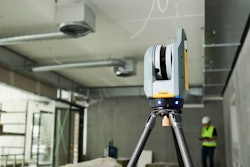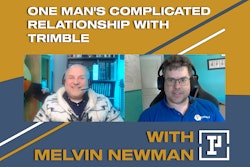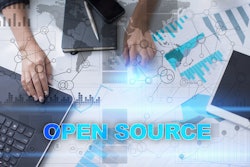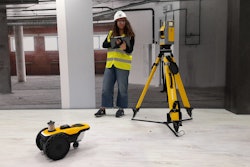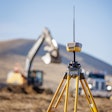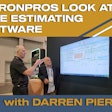
Selecting estimating software is harder now that it was five or 10 years ago. Why? Estimating software most naturally drives value for contractors when it is tightly integrated with other software used in the business—including customer relationship management (CRM) and take-off tools at the front end and then project management, analytics and other applications once the project is won.
This means that estimating software is being pulled closer to these solutions through various means including acquisitions and standard integrations. Contractor executives evaluating solutions for their business will want to conduct due diligence not just into the functionality of the product they are investing in, but the trajectory of the company, its plans for the product and the technical architecture that underpins the software.
This move towards consolidation with software used for other phases of the project lifecycle is just one of three trends contractors need to consider when selecting estimating software. The other two are the shift from on-premise or hosted solutions to the cloud and the introduction of artificial intelligence (AI) as a guide on the side to improve estimating effectiveness.
Extending Estimating Software
Partnerships and integrations are advancing in their ability to unite disparate applications using RESTful application programming interfaces (APIs) and integration platform as a service (IPaaS) vendors like Ryvit and Agave are creating ecosystems of interoperable applications.
READ THE IRONPROS CONSTRUCTION ESTIMATING SOFTWARE WIKI
Some software companies, like CostCertified, are investing in research and development internally to extend its estimating tool with CRM and also developing tools for subcontractor management. Heavy construction tech vendor B2W Software also grew its footprint from the early to later stages of the project. This is true of many other software companies ranging from Stack Construction Technologies, HCSS and more.
“Estimating was our original product,” B2W Marketing Communications Director Greg Norris said. “But we knew that once our customer wins the bid, they need to track the jobs in the field. So we added field tracking software. Then we added scheduling and dispatching, and software to maintain the equipment.”
Any business software category will tend to consolidate over time. This can happen as an estimating software company develops new functionality for later stages in the project or asset lifecycle, or as Stack Construction Technologies did, through acquisition of other products by an estimating software company.
Stack in June of 2021 acquired document viewing, markup and collaboration software company SmartUse Solutions Inc. SmartUse offers optimized interfaces for iOS, Android, and MS Windows devices, enabling mobile document management for construction teams both online and offline. Then in March, Stack acquired project portfolio management software company K-Ops and bidding management technology vendor Bid Retriever.
But more frequently in recent history, it is the estimating software company that is being acquired by the vendor of a broader acquisition suite. The September 2022 acquisition of B2W Software by Trimble is only one case in point. B2W operates in the heavy/ civil space, but the amount of acquisition activity has been particularly heavy in mechanical, electrical and plumbing (MEO) estimating software. MEP estimating product McCormick is now owned by Foundation and Viewpoint Estimating, Quickpen and Accubid are now owned by Trimble. Procore has acquired Esticon and Hard Dollar is now rebadged as InEight Estimating. All of these moves could create opportunities for greater integration between estimating and solutions used across the business.
Questions about project lifecycle capabilities to ask software vendors while selecting estimating software may include:
- How can I round-trip data from finished projects into estimating so I can build a new estimate considering actuals?
- How does the software support handing data from the estimate over to field crews to ensure full understanding of the scope?
Disruptions Caused by Move to the Cloud
Since the announcement of Trimble’s acquisition of B2W, company officials were stressing continuity, suggesting not much will immediately change for the B2W Software product and its customers. B2W will be joining the Trimble Construction One product line along with Viewpoint and other acquired and organically-grown products. While specifics are changing due to the many options Trimble has for how to evolve B2W, the executive team is, based on our debriefings, carefully threading the needle required to bring B2W onto a more modern cloud architecture without disrupting the user experience.
“In the last B2W podcast, it was shared that our solutions will be deployed in the cloud to add value to our customers and end users, not solely to drive value to B2W as a vendor,” Trimble Vice President and Category General Manager Jon Fingland said in an email interview shortly after the acquisition was announced. “Trimble adheres to the same belief. No one chooses to be in the hardware, software, cloud and professional services business all at once. We do it to serve our customers and meet them where they need us. We do it to drive innovation and connectivity. Many Trimble solutions are offered in the cloud, on-prem and mobile. We take on this complexity because we understand our customers and the environments they work in. With that said, the cloud does enable us to serve our customers better. We can develop faster, connect wider and make data available anywhere, anytime. Even in the cloud, we can support online and offline needs, as well as desktop power with mobile computing capacity. The cloud is not only more accessible and reliable, it is more secure. We will continue to leverage the cloud to accelerate our value to the market and we will continue to sell on-prem for the customers that desire that offering. Roughly 70% of our construction management customers today choose the cloud, not because it is our only offering, but because they find value in it.”
By the time of an October 20 debriefing, company representatives painted a more cloud-centric picture for B2W in the intermediate future, built around subscription pricing than the sale of a perpetual license for on-premise provisioning of the software.
“We can’t commit to exact timelines, but we are looking to switch to a pure subscription-based model,” Trimble Product Director Johann Potgieter said. “We are moving away from perpetual, but we need to support our existing customers who do not want to immediately switch to a cloud-based model. And we need to allow customers to stay on perpetual and sell new licenses. But in time we will offer trade-in of warranties and licenses for a subscription-based license.”
A Quest for Success
If Potgeiter's described approach is operationalized, the parts of B2W obscured from users, but responsible for its ability to be performant in the cloud and iterate rapidly, could change. He outlined a plan to use the back end of Lula Build, which had been helmed by Potgieter, in March of 2021, as a delivery system for the familiar B2W functionality.
“Our goal is to bring B2W to market in a cloud-based, browser-based solution,” Potgieter said. “Right now, B2W is still more of a desktop-based, Windows-based application. Quest is a cloud-based application. So we will use some of our Quest cloud-based estimating elements to replatform some of our B2W estimating elements. There could be a converging effort in the future.”
Quest will not be marketed directly in North America according to Potgieter because the way value flows through contracting businesses varies regionally.
“The way in which we approach quantity surveying in the British system is very unit rate, bill of quantities driven,” Potgieter said. “That is really popular in the UK, Middle East, South Africa—we always follow a bill of quantities and almost exclusively unit rate pricing. Whereas what is quite common in the U.S. is you’ll see a mixture between lump sum-based pricing and unit-based pricing so it is not as quantity-centric in the North American market.”
Quest will not have its own go-to-market in North America, but rather will likely serve as a vehicle to deliver the functionality currently in the B2W platform. To be clear, the user experience would come from B2W, but the architecture running behind the software would change to make it friendlier for the cloud.
Contractors need to ask estimating contractor vendors questions about how the software is provisioned (we cover this extensively here on IRONPROS) during their evaluation process.
- How many different ways can the software be provisioned? Some estimating software will be available on-premise and in the cloud. This suggests the cloud version is a hosted solution rather than a more efficient model like a single tenant software-as-a-service (SaaS) product. Or the vendor has one single-tenant SaaS version and an on-premise version, which means they must maintain two sets of code. Creating new features will take longer and there will be more complexity in implementing and updating contractors' instance of the software.
- Who is responsible for ensuring updates to the software will not break my configurations? Hosted or on-premise solutions will usually require some regression testing of updates to ensure they don't cause problems. Determining who bears this burden and the extent of the work required will be important during selection.
Intelligent Estimating Software
Human estimators will not be phased out anytime soon, but estimating software is coming to market with more and more AI features to make humans more effective. No human can conceive of all of the variables that might support, for instance, a go-no-go decision to bid on a project.
Estimators must also assess the scope of the project from both text-based descriptions and drawings or schematics. Sometimes, winning the project is a greater tragedy than losing if you find later critical details or requirements were missed. This is the problem addressed by an estimating AI tool coming to market soon from Zetane.
Patabid, meanwhile, is developing AI estimating tools for the small-to-medium (SMB) contractor. While the company has had a bidding information marketplace, Tenders, on the market for a number of years it in March launched a new product, Quantify, to automate takeoffs using AI. Patabid is also using AI to count plugs, switches, bulbs and other discrete items that drive the cost of bidding for electrical contractors, and perform similar quantification for other subs including mechanical contractors. Combined with the existing Tenders project, Patabid will enable contractors to use AI to quantify the bid, identify risks in the project and also determine, based on who else is bidding on which projects and other criteria, whether they should submit for various opportunities.
These advanced features are more likely to come to modern, multi-tenant SaaS estimating products because the software is easier and faster to iterate for the vendor and more profitable to boot. Some AI-driven tools, like those to embed insurance or lending offers in construction software, may feel someone invasive to contractors, and some contractors may at first actually prefer solutions that do not support these features.
BOTTOM LINE: Estimating comes at the beginning of the construction value chain, and that means an enterprise software vendor with a strong estimating offering can be in a better position to sell solutions that address functions downstream, after the project is won. This means entrepreneurial companies offering estimating will need to have a strong market position or vertical niche and distribution to remain independent. We can expect regular merger and acquisition activity across the construction technology market, but with many estimating software companies subject to recent mergers, contractors evaluating software will want to focus heavily on what any recent acquisition means for the future of the product. Those buying from entrepreneurial companies that would be an attractive acquisition will want to ascertain how technical debt could result in disruption to the product should the vendor be acquired.
